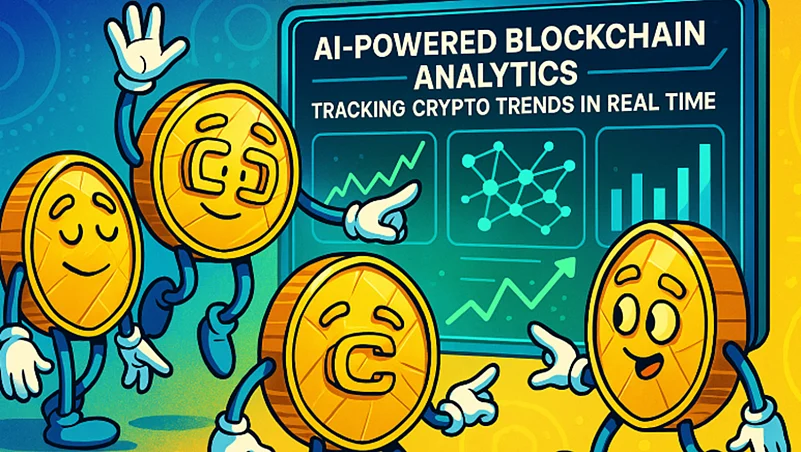In the constantly changing realm of cryptocurrency, change is the only constant. Prices go up and down, new coins emerge, regulatory landscapes change, and public sentiment changes—more often than not, within hours. In a landscape as mercurial, it's not only important to stay current; it's imperative. And yet, with millions of transactions happening on a daily basis and information spread across decentralized networks, how in the world are individuals supposed to keep up?
The answer lies in the powerful combination of two groundbreaking technologies: blockchain analytics and artificial intelligence (AI). Combined, they are transforming how we understand the world of crypto—giving real-time perspective, predicting trends before the masses, and adding context to the enormous quantities of data that typify this digital economy.
Getting Down to Business: Understanding Blockchain Analytics
Blockchain analytics is the analysis and interpretation of data that is stored on blockchain networks. Because blockchains are open in nature, all transactions are recorded in a public ledger. The data consists of timestamps, wallet addresses, and transaction amounts.
But raw blockchain information is too complicated and too large to be useful on its own. Enter analytics software. This software processes the data, breaks it down into pieces, spots trends, and provides insight into money flows in the system.
Add artificial intelligence to this mix, and the possibilities are even bigger.
How AI Amplifies Blockchain Analysis
Artificial intelligence is capable of more than just processing information—it can learn from it. With machine learning algorithms, AI can detect patterns that would escape human notice, predict trends in the market, and even identify suspicious activity.
For example, in the case of there being a spurious trading volume spike for a mysterious token, it can be identified early on by an AI device that notices it, tracks its source, and decides whether it is legitimate interest or coordinated manipulation. This would allow traders, researchers, and even regulators to respond more efficiently and at quicker rates.
AI can also be utilized to analyze public opinion through tracking news, internet chatter, and social media. When a celebrity says a few words regarding Bitcoin or Ethereum, AI technology can gauge the market's emotional reaction and predict potential impacts on price and volumes. These are invaluable to anyone trying to navigate the volatile crypto seas.
Real-Time Insights: A New Era for Decision-Making
In traditional markets, second-long delays can translate to lost opportunities or unexpected losses. Same here, only more so, since it's an all-hands-on-deck 24/7 market with hyper-volatility.
Blockchain analysis by AI introduces real-time monitoring into the equation. Whether it's the identification of emergent token movement changes, tracking of big wallet holder activity (so-called whales), or alerting to unusual patterns of trading, these tools provide insight in real-time.
It is particularly useful for speed-of-things investors who have to move with haste, for developers monitoring network health, and for analysts probing broader market conditions.
Beyond Trading: Other Uses for AI in Tracking Crypto
Even though traders will most obviously benefit from crypto analysis in real time, uses extend far beyond finance.
Fraud detection and security: AI can identify abnormal patterns on a blockchain that can be associated with fraud, money laundering, or hacking.
Regulatory compliance: Regulators and governments are increasingly focusing on crypto activities. AI products help to monitor for anti-money laundering (AML) policy and Know Your Customer (KYC) policy compliance by correlating wallet activity with user behavior and tracking transaction histories.
DeFi and NFT monitoring: DeFi and NFTs are growing the fastest within the crypto space. AI can track action in those spaces—placing focus on the spikes in usage, indicating trends in price, and showing a better sense of ecosystem health.
The Challenges Ahead
Promise as it is, AI-powered blockchain analysis has its pitfalls. The decentralized nature of cryptocurrency can make the data disjointed, and not all blockchains are transparent equally. Also, AI software is only as good as the data that goes into it. If the input is poor or incomplete, the output can be off the mark.
Second is the matter of privacy. As it is largely legal and in the open to trace blockchain data, connecting this to real-world identities needs to be done with caution not to infringe on ethical practices.
A Smarter Way Forward
As the world of cryptocurrencies is expanding day by day, its requirement for even more intelligent tools has never been greater. AI-based blockchain analysis is a step in the right direction—not just when it comes to understanding the marketplace but also while building its future.
By harnessing the power and capacity for learning of AI, we are able to transform raw blockchain data into actionable form, respond to trends in real time, and create a more open, secure, and intelligent digital economy.
As this emerging world takes hold, early adopters of these tools will not simply keep pace with change—they'll dictate the pace.














